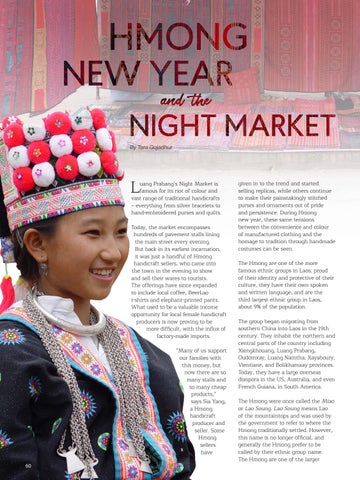By Tara Gujadhur
L
uang Prabang’s Night Market is famous for its riot of colour and vast range of traditional handicrafts – everything from silver bracelets to hand-embroidered purses and quilts. Today, the market encompasses hundreds of pavement stalls lining the main street every evening. But back in its earliest incarnation, it was just a handful of Hmong handicraft sellers, who came into the town in the evening to show and sell their wares to tourists. The offerings have since expanded to include local coffee, BeerLao t-shirts and elephant-printed pants. What used to be a valuable income opportunity for local female handicraft producers is now proving to be more difficult, with the influx of factory-made imports. “Many of us support our families with this money, but now there are so many stalls and so many cheap products,” says Sia Yang, a Hmong handicraft producer and seller. Some Hmong sellers 1 have
60
given in to the trend and started selling replicas, while others continue to make their painstakingly stitched purses and ornaments out of pride and persistence. During Hmong new year, these same tensions between the convenience and colour of manufactured clothing and the homage to tradition through handmade costumes can be seen. The Hmong are one of the more famous ethnic groups in Laos; proud of their identity and protective of their culture, they have their own spoken and written language, and are the third largest ethnic group in Laos, about 9% of the population. The group began migrating from southern China into Laos in the 19th century. They inhabit the northern and central parts of the country including Xiengkhouang, Luang Prabang, Oudomxay, Luang Namtha, Xayaboury, Vientiane, and Bolikhamxay provinces. Today, they have a large overseas diaspora in the US, Australia, and even French Guiana, in South America. The Hmong were once called the Miao or Lao Soung. Lao Soung means Lao of the mountaintops and was used by the government to refer to where the Hmong traditionally settled. However, this name is no longer official, and generally the Hmong prefer to be called by their ethnic group name. The Hmong are one of the larger





